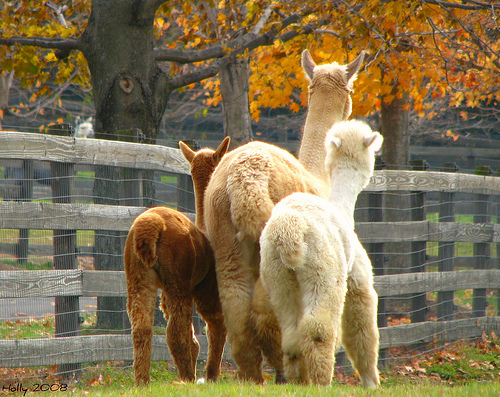Sponsored by the Alpaca Owners and Breeders Association (AOBA), Saturday and Sunday you can visit a local Alpaca farm and learn more about these animals. Why would one want to learn more about them?
Well, if you haven’t been paying attention, Alpacas produce a super soft fiber that is perfect for spinning up into so, much, amazing yarn. And the AOBA wants you to know just how green these animals are. From the AOBA: That is all some kind of amazing. So go ahead, find your local Alpaca farm and get better acquainted with these cute fuzzy quadrupeds. Alpacas prefer to eat tender grasses, which they do not pull up by the roots. Lacking upper teeth, alpacas “cut” the grass with their bottom teeth and upper palate. This vegetation cutting encourages the plant’s growth. Because they are modified ruminants with a three-compartment stomach, alpacas convert grass and hay to energy very efficiently, and stop eating when they are full, further preserving the landscape on which they live. However, alpacas do not mind eating brush, fallen leaves and other “undesirable” vegetation, leaving the “good stuff” for species that do not have the stomach to digest such roughage. Alpacas’ pellet-like droppings are PH balanced, and an excellent, natural, slow release, low odor fertilizer. This rich fertilizer is perfect for growing fruits and vegetables. Because alpacas consolidate their feces in one or two communal spots in the pasture, it is easy to collect and compost, and the spread of parasites is controlled. While alpacas are environmentally friendly … and even beneficial… to the land, what makes them even more “green” is their end product… alpaca fiber. They produced five to ten pounds of luxurious fiber. No chemicals are employed either during feeding or during the industrial production of alpaca fleece into fiber. Alpacas require no insecticides, herbicides and fertilizers which pollute the groundwater. Making this animal even more desirable to animal lovers looking to start a green business, alpacas are not killed. Alpacas are shorn, without harm, every twelve to eighteen months. All fiber from an alpaca can be used. Even the fiber from the lower legs, belly, neck, etc is being used for things such as natural weed mats to be placed around trees. Alpaca fiber is biodegradable. This 100% natural fiber comes in 22 natural colors, offering a full array of choices with no chemical dyes required. If dying is desired, only 20% of a normal dye quantity is required. [Image by loves_taishan under a Creative Commons License]
